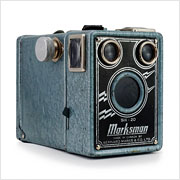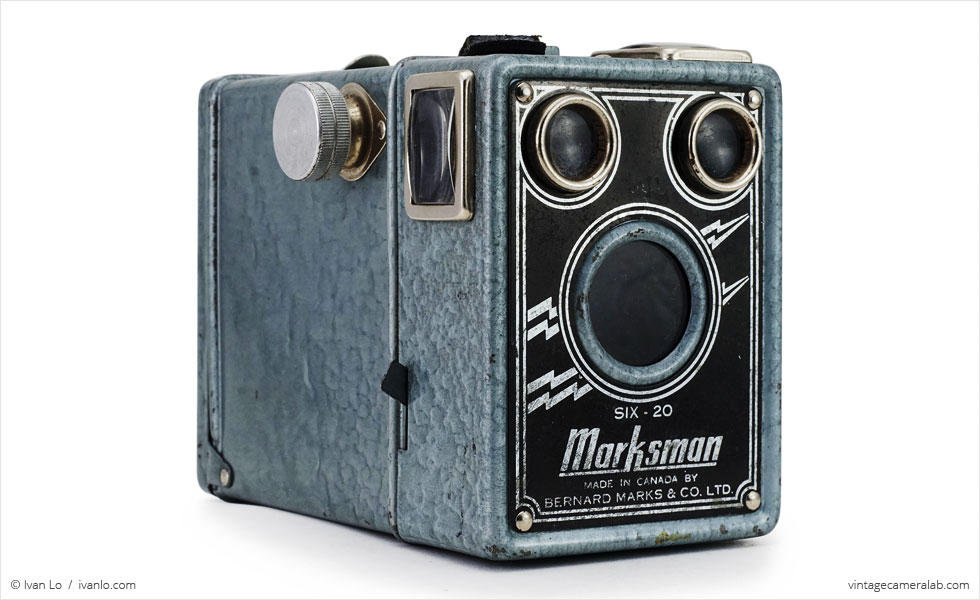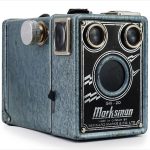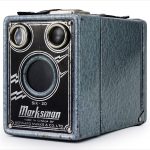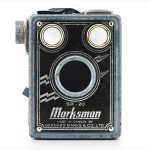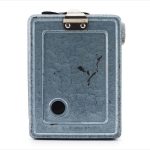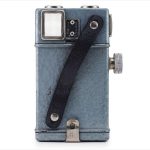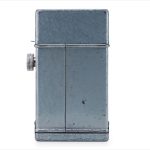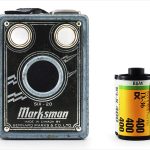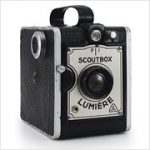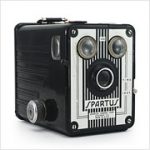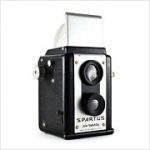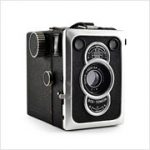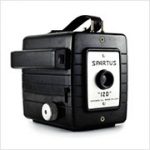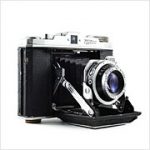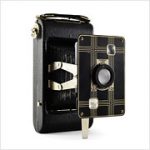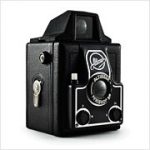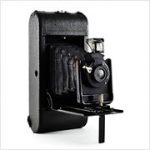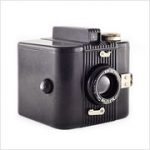Marksman Six-20 Specifications
| Manufacturer: | Bernard Marks & Co. Ltd. |
| Origin: | Canada |
| Made in: | Toronto, Canada |
| Introduced: | 1948 |
| Type: | Box, Viewfinder |
| Format: | 620 Film |
| Dimensions: | 7.6 x 10 x 13 cm |
Marksman Six-20 Overview
The Marksman Six-20 is a no-frills box camera introduced in 1948 and sold by the Bernard Marks & Co. Ltd. of Toronto, Canada. Although both Eastman Kodak and Leica had a long history of manufacturing cameras at their factories in Ontario, many consider the Marksman Six-20 to be one of the only bona fide Canadian cameras in existence, but is it really?
It’s difficult to present the history of the Marksman Six-20 with absolute certainty since the vast majority of any documentation that may have existed appears to no longer be accessible but we do know a few things for sure. We know that there are two versions of the Marksman Six-20 with a few subtle differences; for simplicity’s sake, let’s call them MK1 and MK2. The MK1 model has a more detailed faceplate graphic (thin lines and striped lightning bolts as opposed to the MK2’s thick lines and solid lightning bolts), the MK1’s rectangular viewfinder lenses are convex and extend beyond their metal frames while the MK2’s are completely flat, and it says “MADE IN CANADA BY…” on the MK1 while the wording is “MADE IN CANADA FOR…” on the MK2. We also know that while this camera was primarily sold under the Bernard Marks & Co. Ltd. name (a relatively small retailer in Toronto), the MK1 was also given a different faceplate and sold as the “Teco” by the department store chain Eaton’s, the Canadian equivalent of the US’s Sears Roebuck and Company.
With the facts established, we now venture into the territory of circumstantial evidence. How does a small Canadian company with no history of making or selling photographic equipment before (or indeed after) the Marksman Six-20 suddenly have the resources to design and produce a competent camera? The apparent solution is that they simply didn’t. In the same way that a supermarket chain would contract an outside company to make apple juice for their generic brand instead of planting an orchard and building a processing plant, the most logical thing for Bernard Marks to do would have been to simply license a camera from an existing manufacturer. The most likely answer is the JEM Jr. 120, a metal box camera made in Newark, New Jersey by the J. E. Mergott Company: a brand that, funnily enough, also had no previous experience in the camera industry.
The JEM Jr. 120 was only made for a short time but the design was apparently also acquired by others, resulting in (at least) two clones: the Zenith Sharpshooter and the Empire 120. Because its internal design uses relatively large curves in the sheet metal to help feed the film across the focal plane (as opposed to the Marksman Six-20’s thin rollers), the JEM Jr. 120 / Sharpshooter / Empire 120 is a bit taller but other than that, the cameras are basically indistinguishable. They all have practically identical and identically placed viewfinders (the Empire has convex ones like the MK1 and the Sharpshooter has flat ones like the MK2), winding knobs (note: the JEM Jr. 120 and Empire 120 have key-shaped winders), shutter levers, shutter speed selectors, carrying handles, and hinged film doors. Bearing these things in mind, it seems logical to conclude that the Marksman Six-20 is essentially an updated version of these cameras that utilizes the 620 film format.
It’s possible that Bernard Marks licensed the design and genuinely did produce the camera themselves but there are also rumblings that the parts for the Marksman Six-20 were actually manufactured in Chicago (ostensibly by one of the factories that made the Empire or Zenith versions) and then simply shipped across the border to Toronto for assembly. It’s also possible that the MK1 (which is marked “MADE IN CANADA BY BERNARD MARKS & CO. LTD.”) was legitimately manufactured in Toronto while the lower quality MK2 (“MADE IN CANADA FOR BERNARD MARKS & CO. LTD.”) was put together from ready-made kits sent over from Chicago. At this point, we can only speculate.
From a technical point of view, the Marksman Six-20 is not particularly unusual or advanced. The front plate of the camera is dominated by two viewfinders and a simple meniscus lens. The shutter button, film winding knob, and landscape orientation viewfinder window are located on the user’s right-hand side of the camera while the portrait orientation viewfinder, shutter speed selector, carrying handle, and film door latch are on the top. The hinged film door with red window makes up the entire back plate.
The first thing that caught my eye when I first came across the Marksman Six-20 was its unusual mottled finish and grey-blue color (it was also available in red, black, and dark blue). Then, as I was admiring the design on the faceplate, I noticed the “Made in Canada” label which, even when you count the Kodaks and Leicas made in Ontario, is quite rare. Those things alone were enough to make an otherwise middle of the road box camera appealing to me so I jumped on the first good deal I could find and walked away with this handsome example.
Find your very own Marksman Six-20 on eBay.
McKeown, James M. and Joan C. McKeown’s Price Guide to Antique and Classic Cameras, 2001-2002. (Grantsburg, WI, USA: Centennial Photo Service, 2001), p 188, 305, 452, 730.
Canadian Intellectual Property Office. The Canadian Patent Office Record and Register of Copyrights and Trade Marks, 1948. Volume 76, Part 4, Page XVIII.
T. Eaton Co. T. Eaton Co. Eaton Du Canada Catalogue Ed. Française Automne et Hiver 1950-1951. (Toronto, Canada: T. Eaton Co., 1950), 353, 377.
